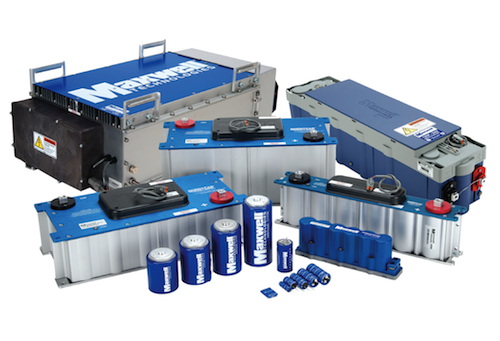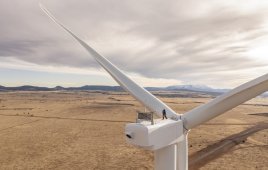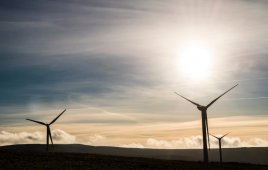
A view inside the hub, before a blade goes on, shows three pitch motors on gearboxes. Ultracapacitors are inside the three smaller enclosures. The large enclosure (center) holds controls.
On modern wind turbines, each blade is adjusted by an independent electro-mechanical pitch-control unit. The electronic controller checks the turbine’s power output several times each second. Should the power output become too high, the controller signals the blade-pitch mechanisms to turn the rotor blades slightly out of the wind. Conversely, when wind velocity decreases, the blades turn or pitch to capture more wind. Such adjustments optimize energy-generation efficiency and avoid stress or damage to the drivetrain, thereby reducing maintenance and extending turbine life.
Future designs for multi-megawatt turbines may include a cyclical pitch control, one in which the pitch adjusts during rotation to compensate for stronger winds above the hub height. For added safety, pitch controls incorporate aerodynamic braking. The rotor attains the full braking effect with a 90° “off” position for all three blades. Even if one blade-pitch unit fails, the other two rotor blades safely complete the braking process. Each autonomous pitch system is equipped with an independent backup power supply to ensure fail-safe operation of the pitchs control and braking functions in the event of a total power failure, or for maintenance.
Energy storage
Electric pitch controls use batteries or ultracapacitors for backup power. Batteries must be sized to satisfy peak-power demands and adjust the rotor blades or activate braking, even when demands occur only for a few seconds. Other battery characteristics pose design challenges for pitch-system engineers. Poor performance at extreme temperatures and a relatively short operational life can lead to periodic replacement throughout turbine life. In contrast, ultracapacitors perform reliably over a wide temperature range (-40 to +65°C), and their long operating life reduces or eliminates need for replacement over the typical life of a wind turbine.
Integrated ultracapacitor power packs
A growing number of wind-turbine manufacturers and leading integrators of pitch-control systems have designed ultracapacitors into pitch drives to take advantage of their all-temperature reliability and long operational life. Pitch controls and drives are located in the rotating rotor hub of the wind turbine or in the blade itself. The power supply and control signals for pitch drives are transferred by a slip ring from the non-rotating part of the nacelle. The slip ring is connected to a unit that includes clamps for distributing power and control signals for the three individual blade-drive units. Each unit consists of a switched-mode power supply, field bus, motor converter, emergency system, and ultracapacitor bank. Switching on the power supply charges the ultracapacitor module to its nominal voltage. Typical charging time is about one minute. The capacitor module has sufficient energy to run the system for more than 30 seconds at nominal power. The ultracapacitor module directly connects to the dc link of the motor inverter, which then drives a 3-phase, 4-pole asynchronous motor mounted directly to the gearbox of the blade drive. The motor delivers its maximum torque at low rpm. Each blade has sensors that control the blade position.

The product line of ultracapacitors from Maxwell Technologies consists of several purpose built modules.
Manufacturers continue designing larger wind turbines. Megawatt-class versions dominate much of the world market, pushing the average installed capacity per turbine near the 2-MW mark. The largest turbines produce up to 7 MW with rotor diameters up to 126 m. Ten-MW units are on the drawing boards. Larger emergency power packs are required to ensure proper blade-pitch functions for such large installations. Ultracapacitor modules rated for 75V are well suited to fulfill the requirements of megawatt-class turbines. To obtain the standard nominal voltage of 300 Vdc used for such wind turbines, four of the sub-modules are connected in series.
Working offshore
Ultracapacitors’ high reliability in extreme temperatures, long operating lifetime and minimal maintenance requirements make them particularly attractive for offshore and remote wind-power applications, with difficult and costly maintenance visits. Unlike batteries, which require ongoing evaluation of their state of health (SOH) and state of charge (SOC), ultracapacitors do not need costly test runs and expensive management systems. Hence, inspection cycles can extend to several months. What’s more, specialized heating systems for cold-climate versions are not required.
Although wind energy contributes about 2% of the total world electricity supply, it is estimated that by 2020 wind’s contribution will grow to over 4%. So within a decade, another 230 GW of new capacity could be installed, which represents a market potentially worth $250 billion. Ultracapacitors have already been installed in nearly 20,000 wind turbines and will play a major role in this expansion. Current trends suggest that ultracapacitors will be instrumental in supporting industry growth by providing a simple, cost-effective, long-life solution for reliable, low-maintenance functioning of pitch control and braking systems.
Looking ahead
A bank of ultracapacitors can also provide static VAR compensation, dc-link backup, and startup power, or any combination thereof for wind turbines and wind farms. For example:
Static VAR Compensators (STATCOM) in wind-energy systems synchronize the current and voltage (i.e. unit power factor) from a generator by supplying reactive power to the system. With excellent cycling and power capability, ultracapacitors are ideal for energy storage that improves the power-quality output of individual turbines or full wind farms. As wind conditions vary, the power output and resulting voltage levels can vary by up to 10% of average output power. Ultracapacitors absorb energy to keep voltage spikes down and release energy to prevent dropouts and so smooths power delivery to the grid. As most events range from milliseconds up to a minute, ultracapacitors provide a cost-effective, maintenance-free solution for power quality issues. STATCOMs have traditionally used other types of capacitors, but the longer life and high capacitance of ultracapacitors provide a better solution.
DC-link backups provide voltage stabilization for wind turbine outputs (power quality) and ensure the wind turbine stays electrically connected to the grid. Grid disconnection can occur from disturbances on the grid side, but more commonly interruptions are on the turbine side due to low winds or from power used by the turbine dragging down the voltage (e.g. pitch motors activating). An ultracapacitor system can provide “low-voltage ridethrough” by maintaining the constant voltage required by the inverter to bring uninterrupted power to the grid. As an added benefit, the same ultracapacitor system can also provide general backup power for the dc-dc link.
Startup Power, a new concept, makes a wind turbine rated for a higher wind conditions usable in lower winds. For example, a Class 3 wind turbine could be usable in Class 4 winds by using a small motor and bank of ultracapacitors to start a lower-wind rated turbine and begin producing in lower winds. This would overcome the main issue of the power required to get the wind turbine started.
Jason Lee
Senior Product Marketing Manager
Maxwell Technologies Inc
San Diego, Calif.
www.maxwell.com
WPE
Filed Under: Components, Turbines







the contact resistance is the resistance between the contact of slip brush or the brush wire with a metal ring
more information:http://www.moflon.com